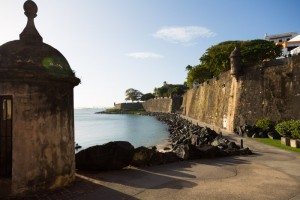Congress is presently debating a bipartisan rescue bill. Banks are closing, businesses are flailing and Gov. Alejandro Garcia Padilla is warning that the territory will be short on an $800 million bond payment due in July. That’s after already missing most of its $422 million payment earlier in this month.
Add to that a 45 percent poverty rate, a population prone to emigration and fears about the Zika virus, and the situation is anything but bright and sunny for the U.S. island that many are calling America’s Greece.

And, while it is not an example of Nero playing while Rome collapses, a recent visit doesn’t seem to show the government’s dire straits hitting the locals all that hard. Tourism initiatives are likewise plowing ahead despite the island’s dour mood and dismal financial reputation.
Citizens may not be exactly “Livin’ la Vida Loca,” but there are signs of commercial activity throughout San Juan. Construction cranes are noticeable, and sold signs frequent the windows in Old San Juan, the historic quarter of the capital city.
“There is a saying here that goes, ‘The government, the banks and these big companies are bankrupt, not the people,’” said Luis D. Muñiz-Martinez, deputy executive director for Puerto Rico Tourism Co. “There definitely are challenges, but go outside and you’ll see people in restaurants — local people, not tourists. You’ll see locals buying ice cream cones. You don’t buy ice cream if you aren’t doing well.”
Some with experience there say that while international competitiveness has been hindered, it’s not as if everything has ground to a halt.
“The government is suffering the pains of the crisis but the economy is still moving in the private sector,” said Sandro Murtas, an Atlanta-based global trade specialist for Synovus Bank, who spent 13 years as director of the International Trade Center at the Puerto Rico Small Business and Technology Development Center. Still, he said, if austerity is imposed, government pain will trickle down to the local economy.
Currently, though, Mr. Muñiz-Martinez said tourism and agriculture are still strong. More than 1.5 million cruise passengers on 500 ships from 18 different lines pass through the San Juan Cruise Port, a stable number compared to previous years.
Delta Air Lines, which says Puerto Rico is vital to its Caribbean strategy, has three to six nonstop flights from San Juan to Atlanta daily depending on the season; four to five nonstop daily from JFK in New York and seasonal once a week flights from Detroit and Minneapolis. These flights fill 1,600 round trip seats per day, 10 percent of which are first class. Most, if not all flights, are at capacity. Traffic is helped by the fact that Puerto Rico is the starting point for many cruises. The strong diaspora in places like New York is also important.
While the community isn’t as strong in Atlanta, Delta’s connectivity to the broader U.S. and international markets is one of its main selling points.
“Demand for the Atlanta flight is bolstered by our industry-leading global network. In addition to local customers, more than 200 destinations with more than 1,000 peak-day departures have direct flights to Atlanta, which allows great connectivity for our four daily Atlanta flights to San Juan,” said Noah Downer, a regional sales manager for the Caribbean at Delta.

Overall, American customers also like that they don’t need a passport to travel to Puerto Rico, as well as the fact that the airport check-in experience mirrors what they’re used to, given that it’s governed by the Transportation Security Administration, Mr. Downer said during a Delta-led media trip to Saborea 2016, an island food festival.
In addition to beautiful beaches, bioluminescent bays, its colonial history and El Yunque, a tropical rainforest national park, San Juan also boasts the largest and most technologically advanced convention center in the Caribbean. Conferences continue to flock to the island, Mr. Muñiz-Martinez said.
“The last years we’ve pretty much beaten every record and we’re at 80 percent capacity across the island,” he said.
In the past three years more than 1,200 new hotel rooms have come on board, including a recently opened Hyatt House and Hyatt Place near the convention center. Also planned is a nearby entertainment center that will feature restaurants, movies and other attractions.
Mr. Muñiz-Martinez said individuals have learned to accommodate the economic realities.
“I had a friend who flew executives around the island in a helicopter. When that business dried up, he flies tourists around San Juan. You’ll see farmers opening food stands and selling their produce. There’s a lot of real estate in San Juan that went into foreclosure. People are buying them at very good prices and turning them into small hotels or condos,” he said. “Instead of looking at this as a crisis, people are looking at this situation as opportunity.”
While new entrepreneurs may be sprouting as a result of the dire economic conditions, Mr. Murtas warned that the government must also focus on growth. With the expiration of tax incentives that brought pharmaceutical companies and other factories to the island, plus high energy costs, it’s now struggling to compete in the sectors that helped it boom during the good times.
“What it will take to bring the economy back is to bring efficiencies in services to private industry,” he said.

Mary Welch
Despite Debt Doldrums, Puerto Rico’s Tourism Industry Plows Ahead
No comments:
Post a Comment